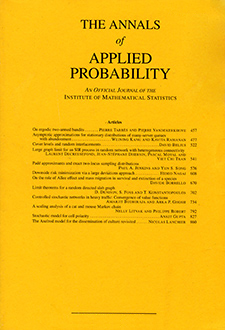Abstract
In the framework of continuous-time, Itô processes models for financial markets, we study the problem of maximizing the probability of an agent's wealth at time T being no less than the value C of a contingent claim with expiration time T. The solution to the problem has been known in the context of complete markets and recently also for incomplete markets; we rederive the complete markets solution using a powerful and simple duality method, developed in utility maximization literature. We then show how to modify this approach to solve the problem in a market with partial information, the one in which we have only a prior distribution on the vector of return rates of the risky assets. Finally, the same problem is solved in markets in which the wealth process of the agent has a nonlinear drift. These include the case of different borrowing and lending rates, as well as "large investor" models. We also provide a number of explicitly solved examples.
Citation
Jakša Cvitanić. Gennady Spivak. "Maximizing the probability of a perfect hedge." Ann. Appl. Probab. 9 (4) 1303 - 1328, November 1999. https://doi.org/10.1214/aoap/1029962873
Information





